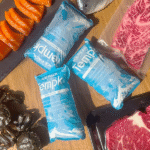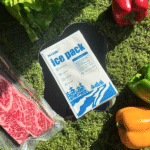How to Pack an Ice Chest with Dry Ice for Maximum Efficiency
Packing an ice chest with dry ice is essential for ensuring perishables remain frozen during transport. Se você está enviando comida, vacinas, ou outros produtos sensíveis à temperatura, dry ice offers superior cooling performance over traditional ice, thanks to its ability to maintain extremely low temperatures. Dry ice’s sublimation process, turning solid CO2 into gas, allows it to cool items without creating water mess. Follow these guidelines to pack dry ice efficiently and safely while complying with 2025 regulamentos.
-
How do I pack an ice chest with dry ice efetivamente?
-
What safety precautions should I follow when using dry ice?
-
What are the benefits of using dry ice in an ice chest?
-
What are the best coolers for packing dry ice?
How Do I Pack an Ice Chest with Dry Ice?
To pack an ice chest with dry ice properly, it’s crucial to follow a structured approach. By taking the following steps, you ensure your goods remain at the desired temperature for extended periods.
-
Escolha o refrigerador certo: Opt for an insulated cooler with thick walls and a vented design. These coolers ensure minimal heat transfer and allow CO2 gas to escape, preventing dangerous pressure buildup.
-
Layer the bottom with regular ice: Layer the cooler’s bottom with regular ice or gel packs. This adds an extra layer of cooling and creates a balanced temperature environment for the dry ice.
-
Add dry ice on top: Place dry ice on top of the products being transported. This is important because dry ice sublimates and releases gas. Leave space for the gas to escape, ensuring the cooler isn’t sealed completely.
-
Ventile o refrigerador: Seal the cooler, but ensure it is vented to allow CO2 to escape. This prevents pressure buildup inside the cooler, ensuring safe transport of dry ice.
Why Use Dry Ice in an Ice Chest?
Dry ice offers several advantages over traditional ice, particularly for industries like cold chain logistics and medical shipping. Ao contrário do gelo regular, dry ice maintains much lower temperatures, keeping goods frozen without adding moisture. This is especially critical for pharmaceuticals, produtos biotecnológicos, e alimentos perecíveis, where maintaining a specific temperature range is non-negotiable.
What Are the Best Ice Chests for Dry Ice?
When selecting a cooler for dry ice, qualidade de isolamento, ventilação, and durability are key factors. Here are some of the best coolers for packing dry ice:
-
High-quality insulated coolers: Coolers with thick insulation, such as those from YETI and RTIC, provide excellent temperature retention and can withstand the extreme cold of dry ice.
-
Dry ice-compatible coolers: Some coolers are specifically designed to handle dry ice, offering optimal venting to prevent gas buildup.
-
Large coolers with tight seals: Coolers with airtight but vented seals are ideal for large shipments that require substantial amounts of dry ice.
| Tipo mais frio | Prós | Contras | Melhor uso |
|---|---|---|---|
| Hard-sided cooler | Durável, excellent insulation | Pesado, volumoso | Viagens longas, heavy-duty cooling |
| Dry ice-specific cooler | Optimized for dry ice handling | Caro, volumoso | Sensitive goods, remessas críticas |
| Standard insulated cooler | Acessível, bom isolamento | May lack dry ice venting | Uso geral, viagens curtas |
Expert Tips for Packing Dry Ice in Ice Chests
-
Use luvas isoladas: O gelo seco é extremamente frio e pode causar queimaduras. Sempre manuseie-o com luvas ou pinças isoladas.
-
Evite o contato direto com a comida: To prevent frostbite on your goods, use a barrier like cardboard between the dry ice and the items being stored.
-
Overestimate your dry ice needs: Como o gelo seco sublima com o tempo, it’s better to have a bit more than needed. Keep in mind that the cooler’s size and external temperature will affect sublimation rates.
Estudo de caso: Efficient Cold Chain Logistics with Dry Ice
A logistics company successfully shipped a batch of vaccines across the country. By carefully layering the dry ice and monitoring temperatures, they ensured the vaccines arrived at the right temperature, meeting regulatory requirements and maintaining product integrity.
Safety Precautions When Using Dry Ice
Handling dry ice requires strict safety measures due to the extreme cold and the risk of CO2 buildup. Here are essential precautions:
-
Use luvas isoladas: O gelo seco pode causar queimaduras graves, so avoid direct skin contact.
-
Garanta ventilação adequada: O gelo seco sublima em gás CO2, que pode deslocar o oxigênio em espaços confinados. Sempre use gelo seco em áreas bem ventiladas.
-
Use recipientes ventilados: To avoid pressure buildup, nunca sele gelo seco em recipientes herméticos. Ensure your cooler has a vent for gas escape.
-
Let dry ice sublimate properly: If you no longer need the dry ice, allow it to sublimate in an open area. Never dispose of dry ice in a sealed container.
Why Is It Crucial to Follow Safety Precautions?
Improper handling of dry ice can lead to serious health and environmental hazards. The extreme cold can cause immediate injuries, while CO2 buildup in confined spaces can lead to suffocation. Always follow safety guidelines to prevent accidents.
| Medida de segurança | Ação | Por que é importante |
|---|---|---|
| Use luvas isoladas | Previne queimaduras pelo frio | Protects hands from injury |
| Garanta ventilação | Work in open, áreas bem ventiladas | Prevents CO2 buildup |
| Use recipientes ventilados | Allow gas to escape | Evita o acúmulo de pressão |
| Allow sublimation | Let dry ice evaporate in an open area | Prevents CO2 accumulation |
How Do I Ensure Proper Temperature for My Goods During Transport?
Maintaining the correct temperature is vital for the safe transport of perishable goods. To keep your products at the right temperature:
-
Monitor temperatures regularly: Use a temperature monitoring device to track the temperature throughout the journey.
-
Layer dry ice for extended cooling: Combining dry ice with regular ice helps maintain a stable temperature.
-
Minimize opening the cooler: Frequent openings will cause the cold air to escape and may raise the internal temperature.
How Does Dry Ice Maintain Low Temperatures?
O gelo seco sublima a -78,5°C (-109.3°F), muito mais frio que o gelo normal, que derrete a 0°C (32°F). This low temperature makes dry ice an ideal choice for maintaining frozen goods without introducing moisture, Ao contrário do gelo regular.
Melhores práticas para controle de temperatura
-
Combine gelo seco com pacotes de gel: This hybrid approach provides the best of both worlds—dry ice for long-term freezing, and gel packs for moderate cooling.
-
Pack the cooler efficiently: Minimize air gaps and optimize the cooler’s internal layout to prevent temperature fluctuations.
| Método de controle de temperatura | Benefícios | Why It’s Effective |
|---|---|---|
| Registrador de dados | Monitoramento contínuo | Tracks temperature for compliance |
| Layering dry ice and regular ice | Balances cooling and moisture control | Ensures prolonged cooling while managing condensation |
| Efficient packing | Prevents air gaps | Reduces temperature fluctuations |
Pro Tips for Packing Dry Ice in Ice Chests
-
Pre-pack your goods: Freeze or refrigerate items before packing them in the cooler.
-
Preencher lacunas: Use towels, crumpled newspaper, or foam to reduce air pockets and slow down sublimation.
-
Ventile o refrigerador: Always crack the drain plug or leave a corner unlatched to allow CO2 gas to escape.
Exemplo: A catering team in Montana successfully transported ice cream for an outdoor event using dry ice. They ensured the dry ice was layered with cardboard separators and vented the cooler, keeping the ice cream frozen for hours even under the summer heat.
2025 Trends in Dry Ice Use for Cold Chain Logistics
Latest Advances in Dry Ice Technology
-
Smart dry ice monitoring: Sensors that track dry ice levels and temperature during transport.
-
Alternativas sustentáveis: The cold chain industry is exploring eco-friendly coolants as alternatives to dry ice.
-
Automation in packing: More companies are adopting automated systems for packing dry ice to reduce human error.
Insights de mercado
The cold chain logistics industry is growing rapidly, driven by the increasing demand for temperature-sensitive products like vaccines, biotech goods, e produtos frescos. Companies are focusing on more efficient and environmentally friendly cooling solutions.
Perguntas frequentes
Q1: Quanto gelo seco devo usar para uma remessa de 24 horas?
Tipicamente, 5-10 pounds of dry ice are recommended for a 24-hour shipment, dependendo do tamanho do refrigerador e das condições externas.
Q2: Posso embalar gelo seco com comida?
Sim, but ensure there is a barrier between the food and the dry ice to prevent frostbite and direct contact with the extreme cold.
Q3: Como faço para descartar o gelo seco?
Let dry ice sublimate in a well-ventilated area. Never dispose of dry ice in confined spaces, trash chutes, or drains.
Conclusão & Dicas acionáveis
Packing an ice chest with dry ice is an excellent method to keep perishable goods cool during transport. By following the correct packing techniques, garantindo a segurança, and using the right tools, you can maintain the proper temperature throughout the journey. Make sure to monitor the temperature regularly, layer your ice effectively, and comply with all safety and regulatory guidelines.
Etapas acionáveis:
-
Use an insulated cooler designed for dry ice transport.
-
Layer dry ice with regular ice for balanced temperature control.
-
Monitor temperatures throughout the journey with a temperature logger.
Sobre TempK
At TempK, somos especializados em oferecer soluções de cadeia de frio de alta qualidade, including dry ice packaging and temperature-controlled transport services. We ensure that your shipments remain at the ideal temperature, Não importa a distância.
Need help optimizing your cold chain logistics? Reach out to us today to learn how we can improve your temperature-sensitive shipments.
























